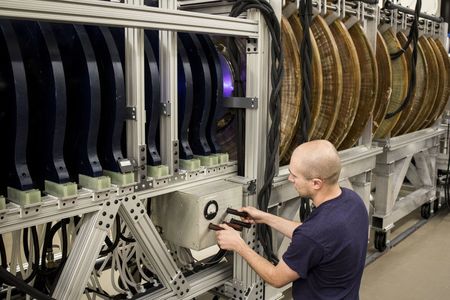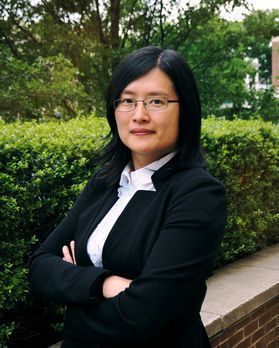
Thomas Steinberger, a physics graduate student in Earl Scime’s lab, adjusts knobs to control the capacitors inside a matching network, allowing researchers to maximize coupled radio frequency power into plasma.
MORGANTOWN, W.Va. -
The Department of Physics and Astronomy
at
West Virginia University
received a $2 million grant from the U.S. Department of Energy to
fund the new Center for Kinetic Experiment, Theory and Integrated Computation
Physics.
The center will integrate experimental, theoretical and computational efforts to investigate some of the most important aspects of kinetic-scale physics in plasmas.

Earl Scime, Oleg D. Jefimenko Professor of Physics and Astronomy and interim dean of the Statler College of Engineering and Mineral Resources
Earl Scime
, the Oleg D. Jefimenko Professor of Physics and Astronomy and interim dean of
the
Statler College of Engineering and Mineral Resources
, will serve as the primary experimentalist for the center and will work alongside
Professor of Physics and Astronomy
Paul Cassak
and Assistant Professor of Physics and Astronomy
Weichao Tu
.

Paul Cassak, Professor of Physics and Astronomy
Plasma is the fourth state of matter and accounts for 99 percent of all visible matter
in the universe, Scime explained. Although you may not realize it, we rely on applications
of plasma physics every day. For instance, the touch screen on your mobile device
is often manufactured using a plasma deposition process.

Weichao Tu, Assistant Professor of Physics and Astronomy
“The center will make significant unique contributions to fundamental plasma physics
problems at kinetic scales, including particle heating and acceleration, wave
generation, energy transfer between ions and electrons and plasma interaction
with surfaces,” Tu said. “These problems have important applications in space
weather, magnetically confined fusion and astrophysical plasmas.”
The focus of the center will be the PHAse Space MApping experiment, or PHASMA. This experiment is designed to make three-dimensional measurements of the motion of ions and electrons at kinetic scales and will be the only facility in the world capable of performing these detailed measurements.
“One of the hard things to study in plasma physics is what happens at very small scales,” Scime said. “Small in plasma is defined as the scale in which the charged particles gyrate around the magnetic field. The size of that orbit is small, and this center will focus on performing particle measurements using lasers at even smaller scales than that.”
This small scale is referred to as the kinetic scale. According to Scime, plasma physicists have yet to fully understand what is happening to the particles at the kinetic scale.
“Because ions and electrons have different masses, their kinetic scales are different,” Scime said. “Once ions and electrons stop experiencing the exact same forces, plasma phenomena get more difficult to predict.”
Better understanding of kinetic scale plasma physics will result in improved modeling for space weather prediction, improved modeling of thermonuclear fusion experiments and improved techniques for manufacturing processes that rely on plasmas.
“What makes the research in this center unique is that the experiment will be capable of measuring the distribution of velocities and positions of the particles in the plasma,” Cassak said.
Most laboratory experiments, especially those relevant to solar and space, cannot measure these distributions, settling only for bulk properties of the plasma, Cassak explained.
“Satellite missions launched into space can measure distributions of speeds of the plasma,” Cassak said. “This will be the first lab experiment to allow us to do a direct comparison with these satellites.”
The center will facilitate collaboration with faculty and students at WVU, as well as faculty and students in four-year colleges throughout the state and researchers at the U.S. Department of Energy’s National Energy Technology Laboratory.
“This center is important for many reasons. It squarely places WVU and its Department of Physics and Astronomy as the epicenter for plasma experiments capable of cutting-edge measurements of charged particle distributions,” Cassak said. “It is important to the state of West Virginia as it provides researchers from smaller institutions in the state an avenue for advanced research.”
The grant was issued as part of a $17 million funding initiative by the U.S. Department of Energy distributed to nine research projects under the federal Established Program to Stimulate Competitive Research program.
“This grant is yet more evidence of the exciting, cutting-edge research our plasma physicists are doing that can be achieved through close collaborations at WVU and across the state,” said D.J. Pisano, associate professor and interim chair of the Department of Physics and Astronomy. “The knowledge we gain from the Center for KINETIC Physics will not only advance the field, it will also give invaluable experience to our student researchers.”
-WVU-
om/7/17/19
CONTACT: Laura Fletcher, Eberly College of Arts and Sciences
304.293.6867;
Laura.Fletcher@mail.wvu.edu